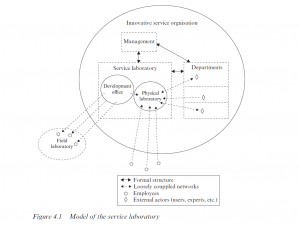A case study of a Scandinavian insurance company with about 4000 employees suggests that service companies of different kind could benefit from a ‘service laboratory’. In the case study, a physical laboratory office with a manager, a vice-manager and four employees was set up by the top management in the insurance company.

The case study as well as the idea in a little more general terms are considered in a new book chapter called “The Lab is Back: Towards a new model of innovation in services”, written by ISE reserachers Jon Sundbo and Flemming Sørensen for “The Handbook of Management and Creativity”.
In the chapter it says that as a model, the service laboratory “bridges two different approaches to innovation in manufacturing and service industries”, i.e. the traditional approach to service innovation, which is rather unsystematic and based on practical experiences, and the manufacturing innovation approach, which has traditionally been based on systematic use of natural and technical sciences “for which the laboratory is the ultimate ideal”.

A new service innovation culture
In the physical laboratory BusinessLab worked with different and often untraditional methods to engage customers and employees in the innovation processes.
An industrial designer, a set designer and an anthropologist was hired to facilitate the lab, and occasionally artists were hired to perform improvisational theatre acts. Role play and focus groups were also used to explore attitudes and interactions.
An advantage to the service laboratory is that compared to normal service innovation procedures, what happened in the case study’s ‘BusinessLab’ was more based on systematic research methods instead of “the typical unsystematic creation of quick ideas based on single customer interactions”. In fact, in the case study, the “BusinessLab has created a new service innovation culture and has implemented new innovation procedures”.
A ‘soft’ organizational machine
Strategic innovation theory is used to explain the roles and relationships that developed between the manager, the vice-manager and the employees in the service laboratory in the case study, while “actor network theory can describe the structure-network relationships” that developed. Hence the service laboratory can be seen as a combination of a structure and social processes. In a way, it is like an organizational machine. On the other hand, the social processes of BusinessLab “take place in both loosely coupled networks and in more formalized network relationships”.
Read more in Chapter Four in “The Handbook of Management and Creativity”.
